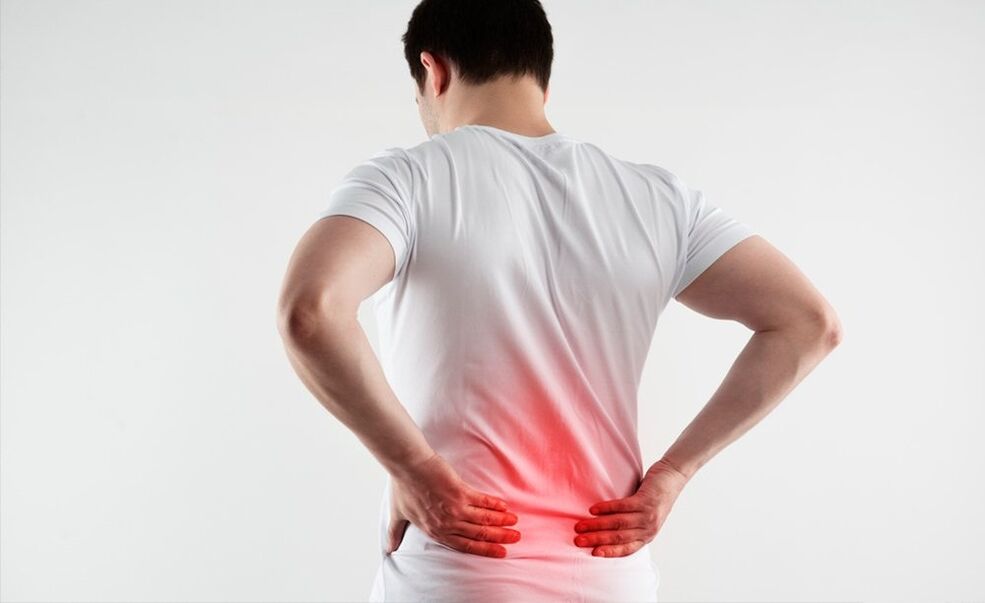Osteochondrosis is a dangerous spinal disease that, if complicated, can permanently worsen the quality of life. This pathology is significantly "younger": various forms of the disease are increasingly common in young people.
Lumbar osteochondrosis: symptoms and drug treatment
Osteochondrosis is called the deformation of the intervertebral discs, cartilage and bones of the spine.
Depending on the location, cervical, thoracic and lumbar (lumbosacral) osteochondrosis are isolated.

The causes of the disease are quite diverse:
- upright posture;
- scoliosis;
- spinal injury;
- flat feet;
- work associated with weight lifting;
- frequent changes in body position;
- spinal overload;
- prolonged stay in uncomfortable positions;
- obesity and low physical activity;
- poor nutrition, accompanied by a lack of nutrients;
- fatigue.
Lumbar Osteochondrosis Symptoms
- First of all, the disease makes itself felt by the pain syndrome. Pain is painful in nature;
- In the lower extremities there is a feeling of pain and, subsequently, numbness;
- Due to the discomfort, motor activity is significantly reduced;
- The pain is exacerbated by lifting heavy objects, strenuous exercise, sudden movements, and even sneezing / coughing.
Lumbar Osteochondrosis Diagnosis
The conclusion is made by the neurologist, based on the patient's complaints. The doctor examines the spine in different positions, at rest / in motion. An X-ray, CT scan, or MRI scan should be ordered to confirm the diagnosis. Based on the results obtained, a whole range of treatments is prescribed: medicines, physical therapy, massage, physiotherapy procedures.
Treatment of osteochondrosis of the lumbar spine with drugs
Drugs should stop the acute process, relieve symptoms, partially restore damaged tissues of the intervertebral discs.
The medicines used are classified according to the type of action:
- Painkillers - eliminates acute pain;
- Non-steroidal anti-inflammatory drugs (NSAIDs) - relieve swelling and inflammation;
- Muscle relaxants: relax spasmodic muscles;
- Glucocorticoid hormones - prescribed in the absence of the effect of other drugs;
- Chondroprotectors: stimulate the regeneration of cartilage;
- Means for accelerating metabolism / blood flow;
- Minerals and vitamins: improve nerve conduction.
Drug treatment for exacerbations
During this time, it is very important to relieve pain. Therapy begins with injections and then continues with tablets. It is very important to start treatment in a timely manner, as inflammation can block the blood vessels and nerves of the affected spine.
Pain is relieved with analgesics and NSAIDs. Opioid analgesics are the most effective but have side effects. NSAIDs are safer in this regard, so they are prescribed more often.
Both analgesics and NSAIDs inhibit the production of prostaglandins, substances involved in the inflammatory process and responsible for pain.
NSAIDs relieve discomfort and inflammation. There are products for external use (gel, ointments), internal (tablets, capsules) and in the form of injections (for intramuscular, subcutaneous, intravenous administration).
Muscle relaxants
Muscle spasm is a response to inflammation. Muscle tension increases pain. Muscle relaxants relax the muscles, respectively, reduce the severity of the disease.
The dosage is selected individually. Therapy with these lasts 2-3 weeks or until the symptoms disappear.
Pain blocks
Blockade with anesthetics is a chipping of the affected area. They can do injections with glucocorticoid drugs. The analgesic effect lasts up to 3 days.
Hormonal treatment
Glucocorticoid hormones have a powerful anti-inflammatory effect. But those are used only in the absence of the effect of less aggressive drugs. Most often complex drugs are prescribed, one of the components of which are hormones. Hormone treatment is associated with a high risk of side effects, therefore it is prescribed for the shortest possible time.
Prepared for external use
With the exacerbation of lumbar osteochondrosis, various gels / ointments are used that have a local warming and warming effect. They can also be anti-inflammatory. Ointments and gels reduce the severity of the symptoms of the disease.
Vasodilators - vasodilators
Muscle spasm and pain cause blood vessels to constrict. To exclude such a phenomenon, a drug is prescribed that dilates blood vessels and improves tissue trophism.
Treatment during remission
During an exacerbation, only those medicines are used that relieve the symptoms of lumbar spine disease, but do not affect its causes. Restorative measures should be performed in conjunction with symptomatic therapy. However, osteochondrosis does not always manifest itself acutely, for example, when the thoracic region is affected, the disease progresses slowly and is chronic. Therefore, in some cases, the treatment does without powerful drugs.
Chondroprotectors help restore the functions of the lumbar intervertebral discs. They saturate the cartilage tissues with useful substances and restore elasticity to the discs.
Chondroprotectors stop the process of destruction of cartilage, stabilize their condition. But these drugs have to be taken for a long time, sometimes for a lifetime. The effect occurs at least six months after starting therapy. Chondroprotectors are used both externally and internally, as well as in the form of injections.
As a basis for such drugs, two active ingredients are taken - glucosamine and chondroitin. The medicine can include one of these substances or both at the same time, as well as being integrated with other active substances.
Examples of chondroprotectors:
- based on glucosamine;
- based on chondroitin;
- with glucosamine and chondroitin;
- with glucosamine, chondroitin and vitamins;
- injection vials.
Medicines to improve blood flow and metabolism
B vitamins, especially B1, B6 and B12, as well as ascorbic acid, have a beneficial effect on the peripheral nervous system. Complex vitamin preparations can be prescribed. Vitamin-mineral complexes are prescribed as a general strengthening.
A preventive course with such drugs will support the health of the spine. Enough 2-3 courses a year to reduce the risk of exacerbation of the disease.
Sedatives (sedatives)
Prolonged discomfort depresses a person, it can cause stress and even depression. In order to prevent the deterioration of the psycho-emotional state, preparations based on motherwort, valerian and combined herbal medicines are prescribed.
If mental disorders are severe, antidepressants are used. Sleeping pills are prescribed to improve sleep quality.












